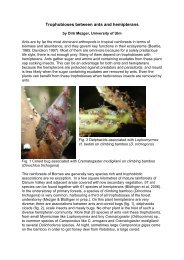Identification guide to the ant genera of Borneo - AntBase.net
Identification guide to the ant genera of Borneo - AntBase.net
Identification guide to the ant genera of Borneo - AntBase.net
Create successful ePaper yourself
Turn your PDF publications into a flip-book with our unique Google optimized e-Paper software.
Y. HASHIMOTO<br />
platform formed by <strong>the</strong> middle and hind coxae, inserting <strong>the</strong> point from <strong>the</strong> right side. Only a small amount<br />
<strong>of</strong> glue should be used, since excessive glue may obscure certain structures necessary for identification. The<br />
height <strong>of</strong> <strong>the</strong> card point on <strong>the</strong> pin will depend somewhat on specimen size, but enough <strong>of</strong> <strong>the</strong> pin should<br />
always be exposed above it <strong>to</strong> be grasped without <strong>the</strong> fingers <strong>to</strong>uching and possibly damaging <strong>the</strong> specimen.<br />
Good height may be obtained by using <strong>the</strong> pinning block.<br />
Fig. 3 illustrates some right and wrong examples for mounting specimen. In well-mounted specimen, <strong>the</strong><br />
side <strong>of</strong> <strong>the</strong> alitrunk, <strong>the</strong> dorsal pr<strong>of</strong>ile, and <strong>the</strong> dorsal and ventral margins <strong>of</strong> <strong>the</strong> petiole are clearly visible<br />
(Fig. 3A). O<strong>the</strong>rwise, in poorly-mounted specimen, <strong>the</strong> legs are projecting upward, obscuring <strong>the</strong> dorsal<br />
pr<strong>of</strong>ile and <strong>the</strong> petiole (Fig. 3B). In <strong>ant</strong>s, <strong>the</strong> area around <strong>the</strong> alitrunk and petiole bear many identification<br />
characters, and <strong>the</strong>refore <strong>the</strong> parts <strong>of</strong> <strong>the</strong> body should be free for easy examination. The head is also import<strong>ant</strong><br />
area for identification. It is advisable <strong>to</strong> push upward a pair <strong>of</strong> <strong>ant</strong>ennae, so that <strong>the</strong>y do not obscure <strong>the</strong><br />
head (Fig. 3C). In many <strong>genera</strong>, <strong>the</strong> palp formula and mandibular dentition are diagnostic characters. One<br />
or more specimens in a series should have <strong>the</strong> mandibles opened and <strong>the</strong> mouthparts everted prior <strong>to</strong><br />
mounting. It is somewhat troublesome and time-consuming work <strong>to</strong> make good mounted specimens.<br />
However, if any identification key is <strong>to</strong> be used with some hope <strong>of</strong> success, specimens must be mounted in<br />
<strong>the</strong> way that <strong>the</strong> characters needed for identification are clearly visible.<br />
A: Well-mounted specimen.<br />
B: Poorly-mounted specimen.<br />
C: Desirable position <strong>of</strong> <strong>ant</strong>ennae and mandibles.<br />
2) Labeling<br />
Specimens without data labels have no scientific value. Therefore, during preparation and mounting,<br />
specimens should bear temporary data labels, and any time a sample is subdivided, <strong>the</strong> label must be copied<br />
so that every specimen continues <strong>to</strong> be accompanied by <strong>the</strong> data. Here, <strong>the</strong> import<strong>ant</strong> points for making <strong>the</strong><br />
labels are described.<br />
A) Paper and Size <strong>of</strong> Label<br />
The paper used for making labels should be thick enough so that <strong>the</strong> labels remain flat and do not rotate<br />
loosely on <strong>the</strong> pin. Label size <strong>of</strong> insect specimen may depend on <strong>the</strong> size <strong>of</strong> <strong>the</strong> insect on a pin. An adv<strong>ant</strong>age<br />
<strong>of</strong> a label that exceeds <strong>the</strong> size <strong>of</strong> <strong>the</strong> insect is that if <strong>the</strong> specimen is accidentally dropped, <strong>the</strong> label may keep<br />
<strong>the</strong> insect from being damaged. However, for <strong>ant</strong> specimens, it is proper that <strong>the</strong> size should be no more<br />
than 12 mm long and 3 mm wide (Fig. 2), because most <strong>ant</strong>s are very small and large labels are inconvenient<br />
<strong>to</strong> handle and examine specimen. If more data are included, more than one label should be used.<br />
92 Part 3 - COLLECTING, HANDLING, IDENTIFICATION AND STORAGE FOR SELECTED GROUPS




